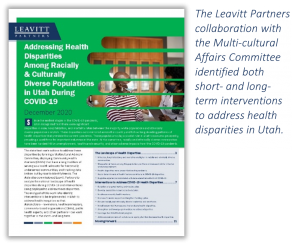Although the traumatic circumstances of the COVID-19 pandemic have exacerbated existing health inequities, it has also fueled an immediacy to address them. The CDC recently released two grant-funded initiatives for state and local health departments to mitigate COVID-19 related health disparities:
- National Initiative to Address COVID-19 Health Disparities Among Populations at High-Risk and Underserved, Including Racial and Ethnic Minority Populations and Rural Communities
- Advancing Health Literacy to Enhance Equitable Community Responses to COVID-19 Department of Health and Human Services
With a combined estimated total program funding of $2.5 billion, many health departments will soon be experiencing a sudden influx of resources. These grants reflect not only a long-overdue prioritization of addressing health inequities throughout the country, but also an opportunity to fortify public health infrastructure and our engagement with traditionally marginalized populations.
In response to the pandemic, Leavitt Partners performed an intervention scan to catalog actions being taken to reduce health disparities. Given the unpredictable evolution of COVID-19, most health department interventions have been short-term responses. The aim of these short-term interventions was to immediately serve communities of color and their specific challenges surrounding COVID-19. Many of these challenges, however, revealed underlying health disparities that will necessitate long-term solutions.
In subsequent conversations with key stakeholders, Leavitt Partners has identified strategic opportunities that state and local health departments could employ to ensure the most effective use of grant funding. Leavitt Partners is eager to see the funding put to good use and is happy to discuss these and other ideas in more detail.
1. DEVELOP A HEALTH EQUITY STRATEGY

Leavitt Partners believes a key opportunity for state and local health departments is to think strategically about key short- and long-term strategies that are designed to be sustainable and scalable. By first doing a systematic analysis and then organizing listening sessions and interviews, health departments can catalogue, assess, and prioritize key interventions in the state.
For example, Leavitt Partners supported the Multicultural Advisory Committee of Utah’s COVID-19 Response to identify short- and long-term strategies that could be applied in the state to reduce disparities. Learnings were catalogued in a report and were presented to various task forces, government leaders, and to the general public to highlight areas that could help reduce disparities across the state. Many of interventions have already begun to be implementing, including eliminating language barriers and establishing a vaccine distribution plan specific to these communities.
2. EVALUATE MULTI-SECTOR COLLABORATIONS AND ALLIANCES

In addition to work being done by state and local health departments, many organizations are already leading efforts that either directly or indirectly address social determinants of health (SDOH). Establishing or nurturing partnerships with these organizations can be a key way to unite efforts to address health inequities. Funding dollars could be used to evaluate the strengths of organizations throughout the state, help identify high-value partnerships, and provide technical assistance to these organizations. Dollars could also be used to establish a better IT infrastructure to centralize referrals between public health, health systems, and CBOs.
The Leavitt Partners-directed National Alliance to impact the Social Determinants of Health (NASDOH) brings together health care, public health and social services expertise, local community experience, community-convening competence, business and financial insight, technology innovation, data and analytics competencies, and policy and advocacy acumen to address current regulatory frameworks, funding environments and opportunities, and practical challenges to implementing and sustaining social determinants of health efforts.
Recently, NASDOH compiled a compendium of resources that provides a framework to create multi-sectoral alliances. The compendium includes resources that will be useful to stakeholders at all stages of the process, including those that are investigating multi-sectoral approaches, in the process of developing one, and established alliances that are looking for guidance on certain topics.
For more information about NASDOH, visit https://www.nasdoh.org/
3. DESIGN A SUSTAINABLE CHW PROGRAM
A robust Community Health Worker (CHW) program is an effective way to disseminate health information, promote public safety measures, share knowledge on preventive care and healthy lifestyles, and help communities overcome vaccine hesitancy. However, many CHWs are funded through short-term grants and have a de-centralized training and resource system. The recently released CDC grants could establish infrastructure and programming to provide coordination, training, and resources that will foster longevity to a CHW program. Leavitt Partners recommends that state health departments conduct secondary and primary research to inform the design of a sustainable CHW program in their state.
4. DEPLOY RAPID COMMUNITY ASSESSMENT(S) FOR VACCINE CONFIDENCE
The CDC recently published guidance to help state and local health departments better understand what is driving vaccine confidence in communities. The documents outline steps to identify communities of focus and understand the drivers of confidence, and then develop intervention strategies to increase confidence. However, it could be difficult for health departments—which are already strapped for personnel—to deploy on their own. This CDC grant funding could be used to identify a partner to assist health departments in operationalizing this plan, analyzing learnings, and recommending strategies to increase vaccine confidence.
5. EVALUATE AND IMPROVE RACE & ETHNICITY DATA FLOW
In many states, the extent of health disparities is unknown due to gaps in race and ethnicity data collection in healthcare and health surveillance, both related to COVID-19 and other health issues. The data that does exist often has known quality issues. Collecting and reporting comparable, granular data is a crucial step in reducing health disparities.
Leavitt Partners recently analyzed how race and ethnicity data travel through the healthcare system during the COVID-19 pandemic and how much of this information gets lost along the way. Health systems, payers, and government entities must implement best practices and standards to improve data quality. Ultimately, solving race and ethnicity data gaps will require multiple solutions by multiple stakeholders, and health departments could use this funding to identify the specific race and ethnicity data gaps in their state and how they can better collect this information and turn it into actionable strategies to address health disparities.
6. EVALUATE THE COVID RESPONSE IN PRIORITY POPULATIONS
Leavitt Partners also recommends that health departments evaluate the COVID response to date among priority populations to identify what has worked well, what hasn’t worked, and what can be done differently moving forward. This effort could focus on a geographic area or on a specific population. The evaluation could include collecting information from priority populations, advocacy organizations, and COVID response teams through in-depth interviews, focus groups, and/or surveys.
Leavitt Partners has done this type of work previously among racially and ethnically diverse men. Rates of diabetes are higher in Black, American Indian, and Hispanic communities, but approaches to chronic disease prevention are not always optimized for these cultures. Through a literature review, surveys, and focus groups, Leavitt Partners supported the National Association of Chronic Disease Directors to identify key elements and principles that can be incorporated into interventions to increase enrollment and retention of racially and ethnically diverse men in the National Diabetes Prevention lifestyle change program and the Diabetes Self-Management, Education, and Support program.